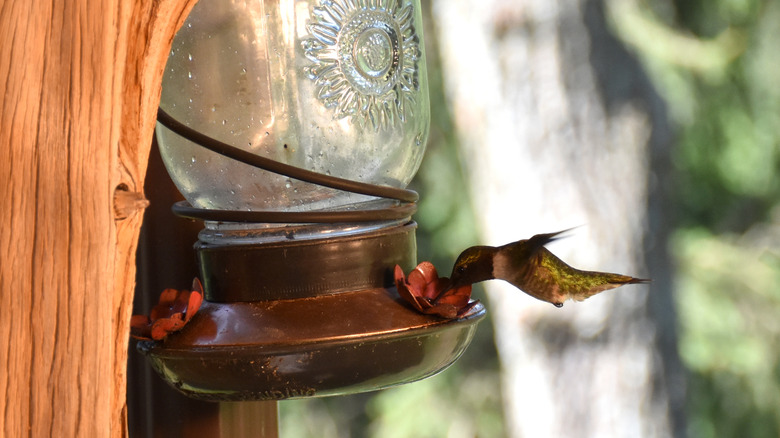The Vinegar DIY To Clean Your Mason Jar Hummingbird Feeder (Safe For Birds)
If you want to keep the hummingbirds that frequent your yard safe and healthy, regularly cleaning your feeder is a must. Without routine cleanings, your mason jar hummingbird feeder runs the risk of developing mold, which can lead to pathogenic diseases for the adorable little birds. When wondering how to safely clean your hummingbird feeders, you might think that regular dish soap and hot water is the way to go. In reality, however, it's far safer to use vinegar. By simply soaking your feeders in a mixture of warm water and vinegar, you can efficiently clean them without leaving behind any harmful soap residue.
In addition to being safe for birds, this method is also a low-effort solution that you can easily incorporate into your pre-existing cleaning routine. Keep in mind that in humid climates or during the summer, it's important to clean your feeder more frequently. If the outdoor temperature is 89 degrees Fahrenheit or higher, daily cleaning is best. Otherwise, every two to three days should be sufficient.
How to clean your hummingbird feeder with vinegar
Using dish soap is one of those common mistakes everyone makes when cleaning hummingbird feeders. While it may seem like a safe option, you run the risk of leaving behind a small amount of soap residue on the glass. This residue can be harmful to the birds, even in small amounts. That's where vinegar comes in. To use the vinegar method, start with an empty, disassembled hummingbird feeder. Then, create a solution of two parts water and one part distilled white vinegar and allow the feeder and all of its parts to soak in the mixture. Soaking will help loosen any stuck-on nectar or debris. After about two hours, you can begin scrubbing the feeder with a bottle brush. If you don't already own one, look for a brush with dual end that can scrub both the mason jar and the feeding ports with ease.
While scrubbing, be sure to remove any nectar residue or mold that may be stuck to the inside of your feeder. After a good scrub, rinse your feeder off thoroughly under the tap and set it aside, allowing it to dry completely. Once it's dry, the feeder is ready to be refilled with nutritious nectar. To avoid harmful additives and dyes in store-bought nectar, consider this homemade hummingbird nectar that's surprisingly easy to make.

